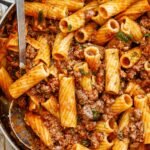-
 Beef Pasta in Flavorful Tomato Sauce: A Homestyle Comfort Dish
Beef Pasta in Flavorful Tomato Sauce: A Homestyle Comfort Dish -
 Is it Possible to Boost Your Metabolism Safely and Naturally?
Is it Possible to Boost Your Metabolism Safely and Naturally? -
 Time-Honored Soul Food Recipes from the Queen of Authentic Soul Food Cooking
Time-Honored Soul Food Recipes from the Queen of Authentic Soul Food Cooking -
 Healthy Toast Toppings 2024
Healthy Toast Toppings 2024 -
 The Best Easter Dinner Ideas 2024
The Best Easter Dinner Ideas 2024 -
 Healthy New Year's Dessert Recipes
Healthy New Year's Dessert Recipes -
 Crispy chicken KFC Zinger Sliders Low Calorie, High Protein
Crispy chicken KFC Zinger Sliders Low Calorie, High Protein -
 Top 5 Adaptogen Drinks: Boost Mood, Energy
Top 5 Adaptogen Drinks: Boost Mood, Energy -
 Sugar and Gluten Free No Bake 10 Minute Brownies
Sugar and Gluten Free No Bake 10 Minute Brownies -
 10 Healthy Dinners Ready in 30 Minutes or Less
10 Healthy Dinners Ready in 30 Minutes or Less

Food comprises water, lipids, proteins, and carbohydrates, with minerals and organic substances also present. While some organisms produce nutrients, animals ingest for nutrition. Human diets classify by content or processing. Common groups are Vegetables and Fruit, Cereals and Bread, Dairy, and Meat, reflecting origins and functions. Other systems categorize by diet quality, such as whole grains, vegetables, fruits, nuts, legumes, and meats. International organizations like FAO and WHO use detailed classifications like cereals, roots, pulses, milk, eggs, fish, meats, vegetables, fruits, fats, sweets, spices, beverages, and additives. These frameworks aid understanding diversity and nutrition. Efforts to improve the global food system involve promoting sustainable agriculture, reducing waste, and supporting small-scale farmers. Recognizing indigenous knowledge aids biodiversity and resilience. Collaboration among governments, NGOs, businesses, and individuals is vital for sustainable, equitable, and economically viable systems. Security is monitored by agencies like the International Association for Protection, the World Resources Institute, and the World Programme, ensuring sustainability, equity, and resilience while addressing food waste and climate change impacts. Јewelryartcorner Јewelryartcorner
Food, a substance primarily composed of protein, carbohydrate, fat, and various nutrients, is essential for sustaining growth, vital processes, and providing energy to the body of an organism. Plants, which convert solar energy into through photosynthesis, serve as the primary source of . Animals that consume plants often become food sources for other animals.
Humans have adapted to their environments and sustenance through various means such as hunting and gathering, horticulture, pastoralism, and the development of agriculture. Food has played a significant role in carrying culture within human societies and has been a catalyst for globalization. This was particularly evident during the early phases of European trade and colonial expansion, when foods like hot red peppers, corn (maize), and sweet potatoes spread from Europe to Africa and Asia, shaping culinary traditions worldwide.